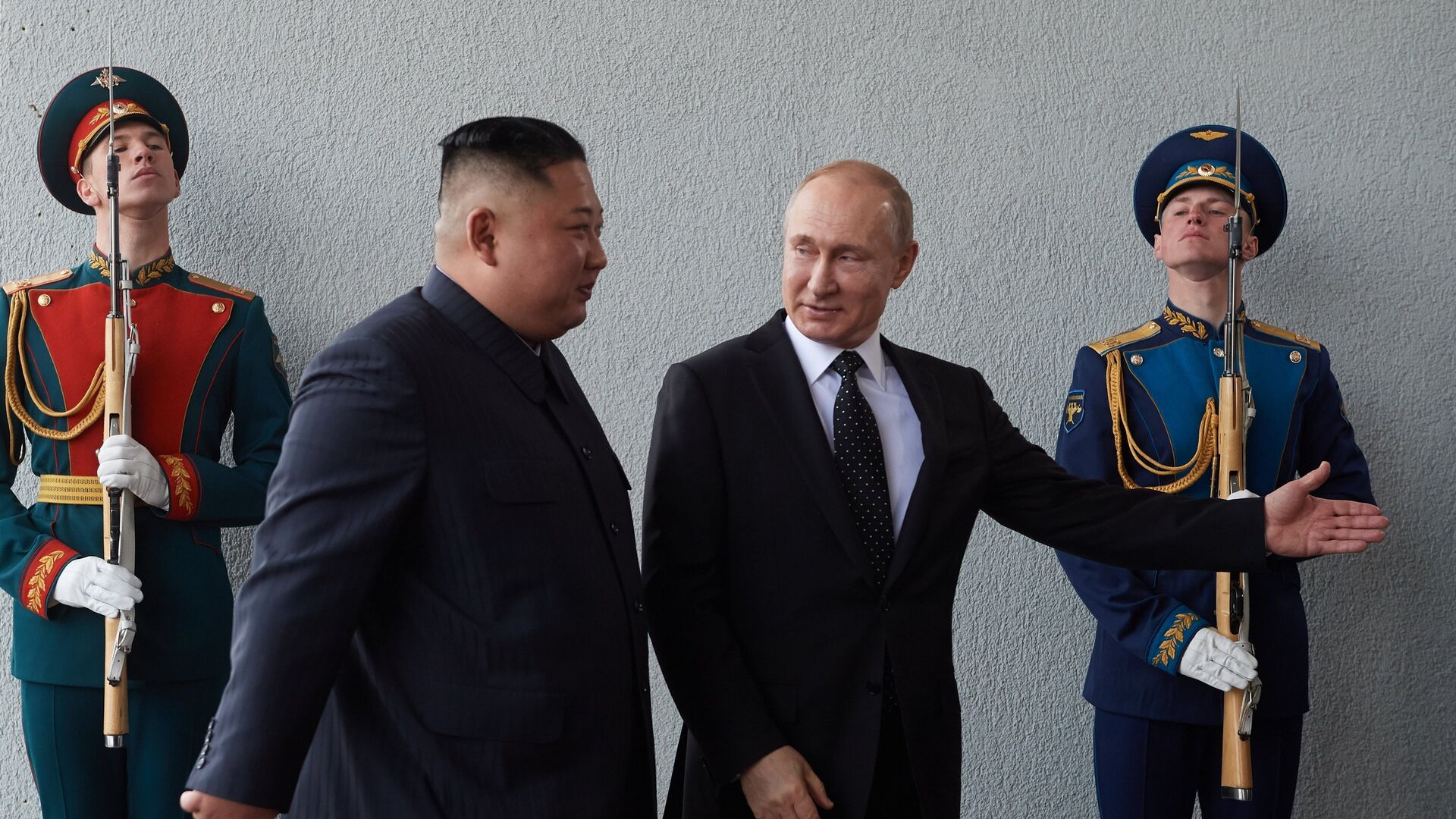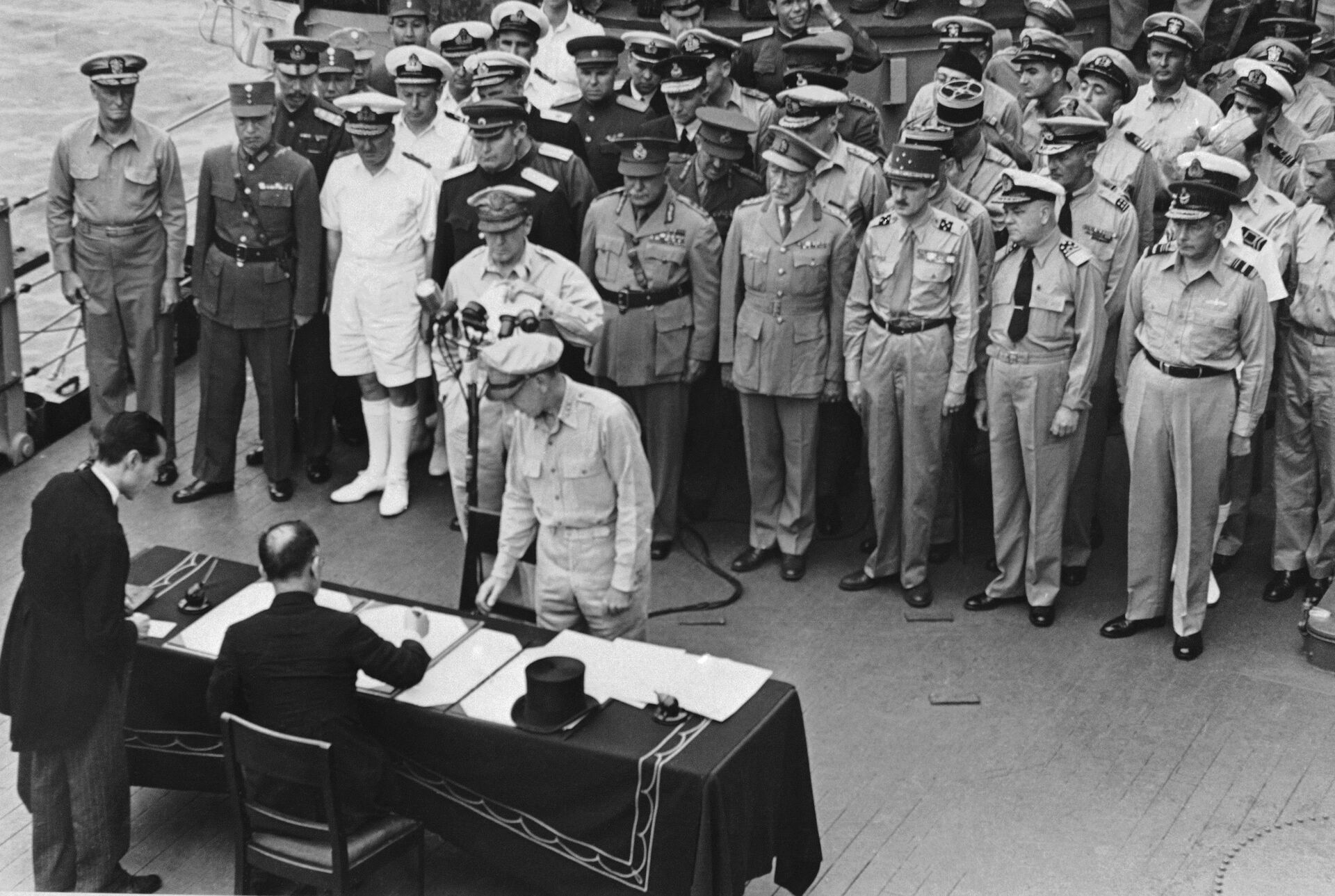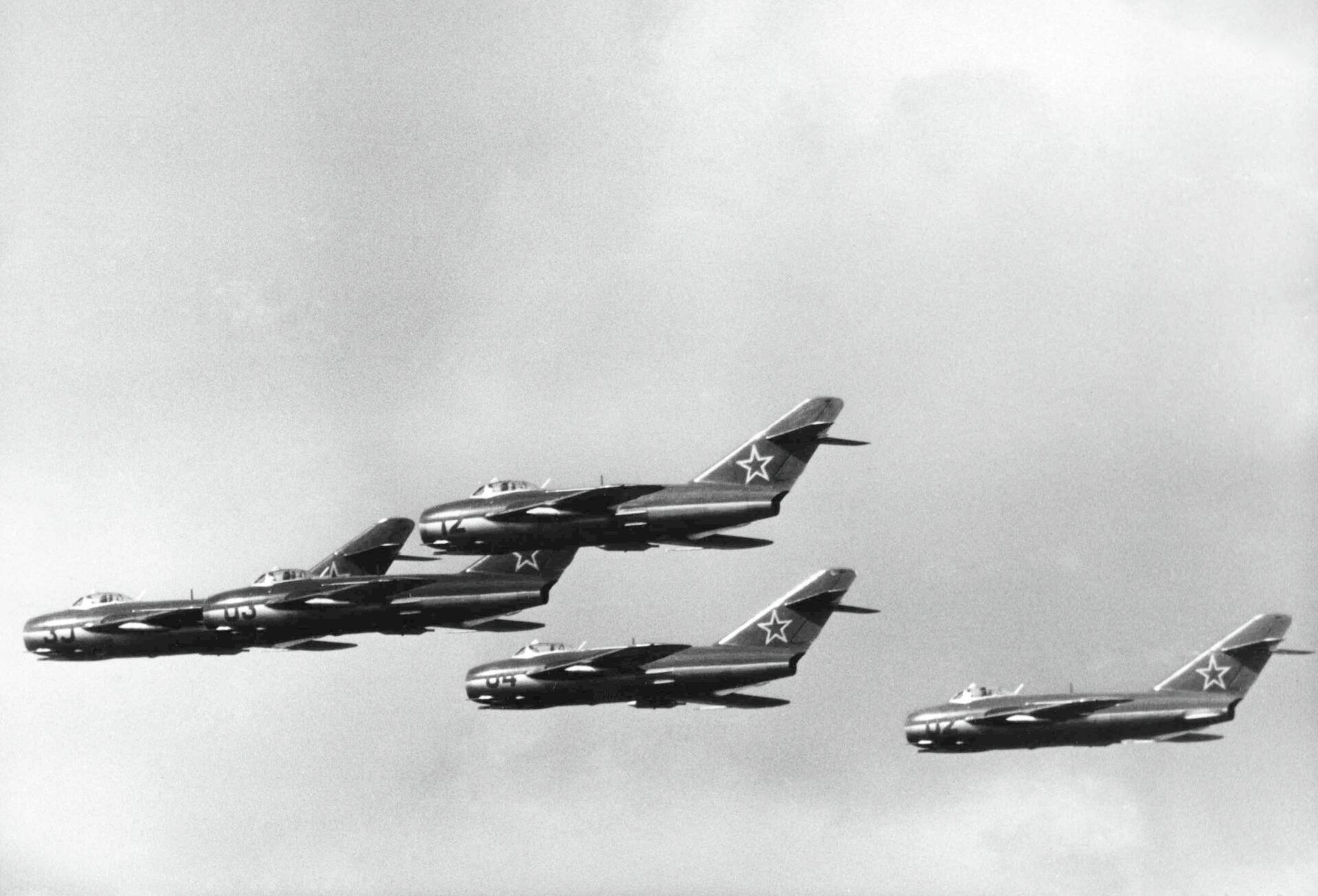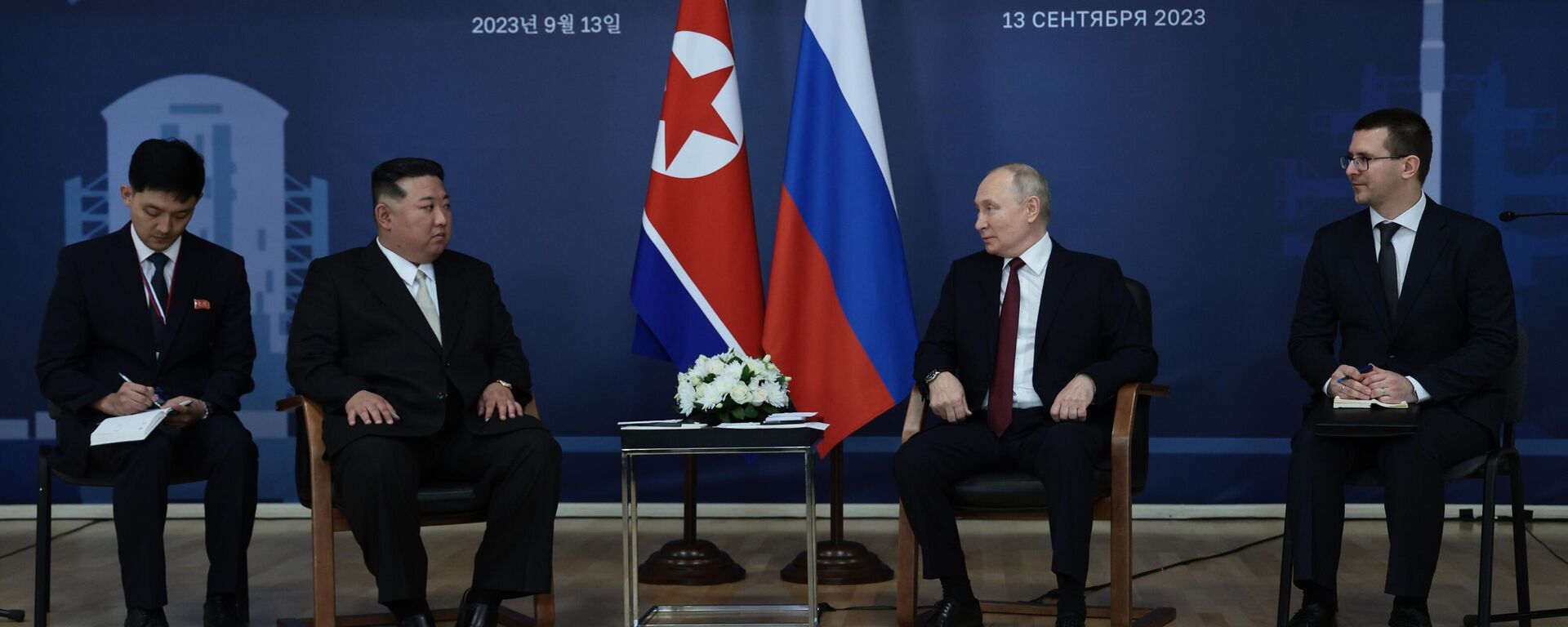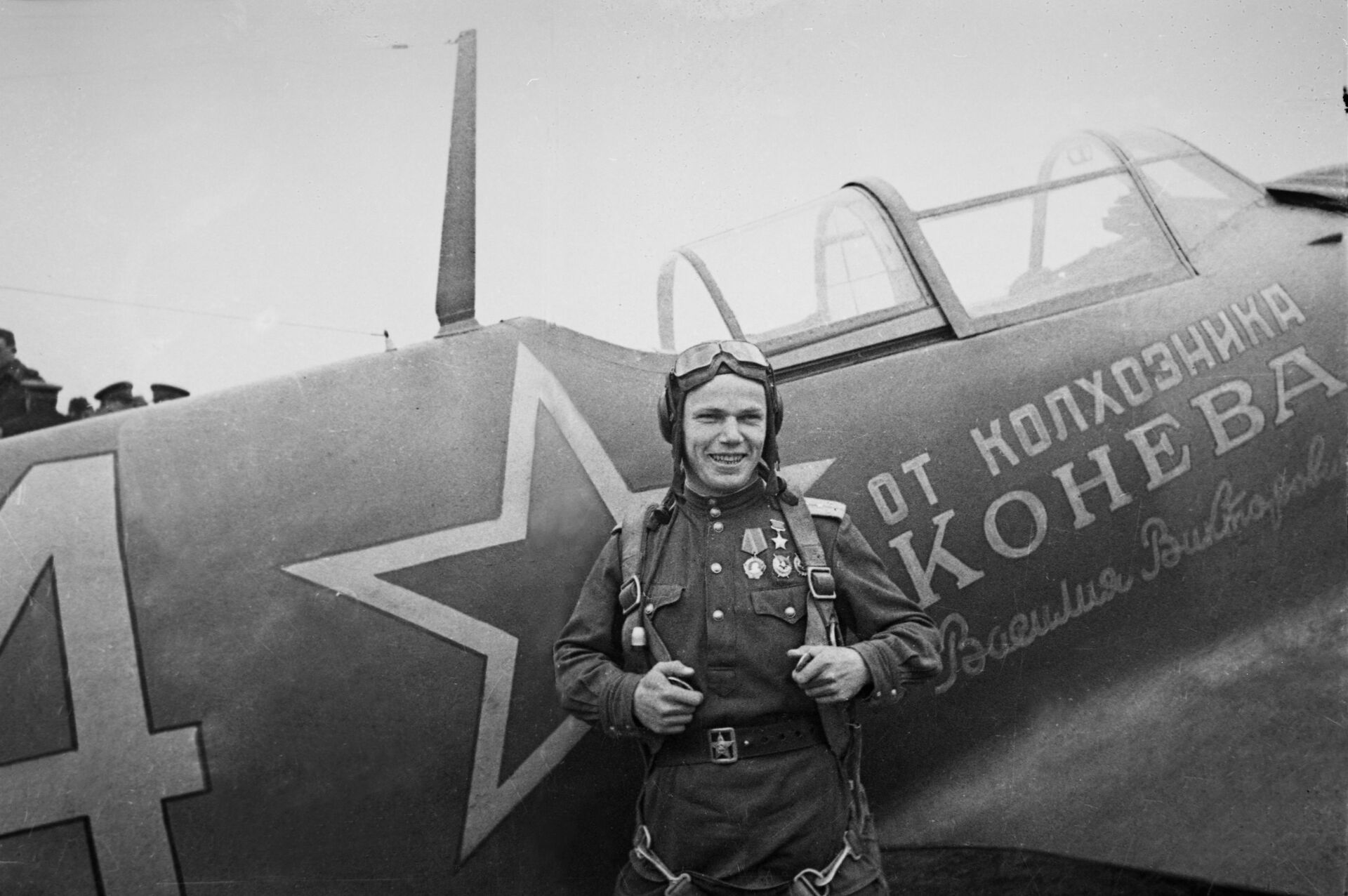https://en.sputniknews.africa/20230913/1062084159.html
Despite All Odds: Why Are Relations Between North Korea and Russia Strong?
Despite All Odds: Why Are Relations Between North Korea and Russia Strong?
Sputnik Africa
In the midst of the Eastern Economic Forum (EEF), which is being hosted by the Russian Pacific city of Vladivostok, North Korean leader Kim Jong-un is... 13.09.2023, Sputnik Africa
2023-09-13T12:55+0200
2023-09-13T12:55+0200
2023-09-13T12:55+0200
features
russia
international
vladimir putin
mikhail gorbachev
soviet union (ussr)
democratic people's republic of korea (dprk, north korea)
eastern economic forum (eef)
kremlin
asia
https://cdn1.img.sputniknews.africa/img/07e7/09/0d/1062084411_0:181:2995:1866_1920x0_80_0_0_1ccd40e2a2eb353de4d8df5ff74109a5.jpg
The Kremlin announced on September 11 that Chairman of the State Council of the Democratic People's Republic of Korea (DPRK) Kim Jong Un would visit Russia at the invitation from Russian President Vladimir Putin. The North Korean leader arrived in Russia on Tuesday, with his first stop being the Primorsky region's Khasan station, where he was welcomed by a Russian delegation.Moscow has maintained longstanding relations with Pyongyang, which originated at the very beginning of the Cold War era. How did this relationship start?When Did Moscow Establish Relations With North Korea?Diplomatic relations between the Soviet Union and the DPRK were established on October 12, 1948, soon after the foundation of the North Korean state on September 9, 1948.Prior to that, the Red Army had liberated Korea from Japan's occupation. On August 8, 1945, the USSR declared war on Japan and on August 9 began military operations against the Japanese Kwantung Army in Manchuria and Korea. The successful missions were conducted by Red Army troops in cooperation with the Soviet Pacific Fleet and the Red Banner Amur Military Flotilla.The Japanese forces were defeated. On August 14, 1945 Japanese Emperor Hirohito broadcast the surrender to the Japanese people on Radio Tokyo. Thus, August 15 became the national liberation day for both North and South Korea.On September 8, 1945, the US military, which was an ally of the USSR at the time, landed on the Korean Peninsula. The governments of the US and the USSR reached an agreement that Korea would be divided along the 38th parallel into northern and southern zones in order to more effectively organize the surrender of the Japanese Army.However, shortly after the end of the Second World War, the Cold War started, marked by Winston Churchill's famous "Iron Curtain" speech at Westminster College in Fulton on March 5, 1946.South Korea was the first to distance itself from the North. On August 15, 1948 the pro-US Republic of Korea (or South Korea) was established in Seoul, led by the strongly anti-communist Syngman Rhee.In response, Pyongyang declared the formation of the DPRK with Kim Il-sung taking the reins of the North Korean government.The withdrawal of Soviet troops from the DPRK was completed on December 26, 1948 and a new chapter of cooperation between Pyongyang and Moscow began. The Soviet Union played a substantial part in the restoration of the DPRK economy. The USSR funded the construction of heavy industry enterprises in North Korea; dispatched Soviet civil specialists; as well as supplied food, fuel, and transport.How Did the USSR Help North Korea During the Korean War?Meanwhile, in the late 1940s, the Cold War between the "capitalist" and "socialist" camp erupted. In the 1950s, the US started its overseas operations in Southeast Asia under the pretext of the later debunked "domino effect" concept.A memorandum from the Board of National Estimates to the Director of Central Intelligence, dated June 9, 1964, explained that the "'domino effect' appears to mean that when one nation falls to communism the impact is such as to weaken the resistance of other countries and facilitate, if not cause, their fall to communism."After five years of simmering tensions on the Korean Peninsula, the Korean War started on June 25, 1950, with Seoul and Pyongyang laying the blame for the beginning of the conflict at each other's door. Just two days later, on June 27, 1950, US President Harry Truman announced that the US was entering the war on the side of South Korea to repel North Korea's "invasion."Judging from historical documents, on October 1, 1950, when American and South Korean troops were advancing to the north of the Korean peninsula, Chairman Kim Il-sung sent a letter to his Soviet counterpart Joseph Stalin requesting military assistance. Moscow immediately responded to the request.In early October, the USSR and the DPRK agreed on transferring Chinese military volunteers into North Korea, while the Soviet General Staff was assigned to form a fighter aviation corps in Northeast China. This air corps operational group was created by order of the Soviet General Staff No. 5564 of November 15, 1950.The Soviet Air Force played a crucial role in upholding North Korea's sovereignty. Legendary Soviet fighter pilot Ivan Kozhedub – credited with over 60 solo victories during the Second World War – was sent by Moscow along with other pilots to the DPRK.According to some estimates, Soviet MiG-15 fighter jets flew a total of 64,000 combat sorties, taking part in more than 1,900 air battles during the Korean War. As a result, the US lost 1,100 aircraft, including 651 then-ultra-modern F-86 fighters, in the course of the conflict. For comparison's sake, the USSR lost 319 warplanes.On July 27, 1953, hostilities ceased, with the warring parties inking an armistice agreement to establish a demilitarized zone (DMZ) along their shared border (248 km). The two Koreas remain split along the 38th parallel to this day. Even though the US does not recognize defeat in the Korean War, it sustained serious losses, did not gain ground beyond the 38th parallel, and failed to oust the Communist government in Pyongyang, let alone establish control over the peninsula.How Did Soviet-DPRK Relations Evolve After the Korean War?After the end of the Korean War, the USSR again stepped in to help Pyongyang restore the county following the devastation. Moscow allocated a hefty package of aid to bring the DPRK economy back on track. The USSR participated in rebuilding and expansion of the Kim Chaka metallurgical plant, Sendin Steel Plant, Heungnam Chemical Fertilizer Plant, Nampo Non-ferrous Metals Plant, and Seunghori Cement Plant, to name but a few. Moscow provided its East Asian ally with necessary materials, equipment, transport, and inventory. The USSR also actively contributed to the restoration of hospitals, schools, and scientific and technical centers.In 1955, a bilateral agreement on scientific and technical cooperation was signed. Among other things, the agreement provided for the transfer to the DPRK of all necessary Soviet scientific and technical documentation free of charge. In 1959, the Soviet program for comprehensive support in the construction of new industrial enterprises in North Korea caught its second wind. In 1961, an official exchange of students between the USSR and the DPRK began.The Soviet Union continued to maintain working relations with Pyongyang and provide assistance to North Korea up until the collapse of the USSR in 1991. However, Russia's abandonment of the Communist doctrine as a centerpiece of its state ideology did not spell the end of the longstanding ties between Moscow and Pyongyang.North Korea officially recognized the Russian Federation as the legal successor of the former USSR. On February 9, 2000, a new interstate Treaty of Friendship, Good-Neighborliness, and Cooperation was signed in Pyongyang. It replaced the outdated document of 1961, according to which the USSR and the DPRK were military allies.How Often Did North Korean Leaders Visit USSR, Russia?Chairman Kim Jong Un's predecessors paid many high level state visits to their Soviet (and later Russian) counterparts. Here are just a few of them:Kim Il-sung's first trips as head of the DPRK to the USSR took place on March 3-25, 1949 and in April 1950. Joseph Stalin made an iconic gift to his North Korean counterpart at the time: an armored carriage, which is currently on display in a DPRK museum.In the summer of 1956, Kim Il-sung toured the USSR, Eastern European countries, and Mongolia. On June 4-5, 1956, in Moscow, the DPRK chairman met with First Secretary of the Soviet Communist Party Nikita Khrushchev.On June 29, 1961, the North Korean leader met with the Chairman of the Presidium of the Supreme Council of the USSR Leonid Brezhnev. On July 6, 1961, the nations inked the Treaty of Friendship, Cooperation, and Mutual Assistance. The treaty provided, in particular, for military support of the DPRK by the Soviet Union in the event of interference of third countries in North Korea's affairs.On May 16-27, 1984, during his tour of the countries of the Socialist camp, Kim Il-sung met with his Soviet counterparts in Moscow and the sides agreed on the construction of a nuclear power plant in the DPRK. Unfortunately, due to the collapse of the USSR, the project was not implemented.On October 24, 1986 the DPRK chairman met in Moscow with Soviet leader Mikhail Gorbachev. The leaders of the two countries discussed inter-Korean relations, with Kim Il-sung speaking in favor of concluding a non-aggression agreement between North and South.Kim Il-sung's successor, Kim Jong-il – who was the second DPRK chairman from 1994 to 2011 – visited Moscow in 2001.Kim Jong-il's visit to Russia lasted from July 26 to August 18, 2001. On August 4, he met Russian President Vladimir Putin in Moscow. The leaders discussed the situation on the Korean Peninsula and issues of inter-Korean settlement, strategic stability, and trade and economic cooperation.The leaders signed the Moscow Declaration, agreeing "to promote the formation of a new fair world order system based on the priority of law, the principles of equality, mutual respect, mutually beneficial cooperation in the interests of preserving global stability." Kim Jong-il traveled on an armored train through Russia, repeating the route of his father.Kim Jong-il's second visit to Russia took place on August 20−24, 2002, while his third Russia trip occurred on August 20−25, 2011. The North Korean leader traveled through Russia's Far Eastern and Siberian federal districts to Buryatia, where he held negotiations with then-Russian President Dmitry Medvedev on August 24. The sides discussed plans for the construction of a transit railway and a gas pipeline from Primorye to South Korea. In addition, Moscow wrote off 90% of North Korea's $11 billion debt.On April 24, 2019, Chairman Kim Jong Un’s armored train crossed the Russian border in Primorye. Kim Jong Un traveled to Vladivostok in his trademark armored train. On his way to the port city, Kim made a brief stop at the Khasan border station to visit the House of Russian-Korean Friendship, built in 1986 on the eve of Kim Il-sung's visit. He met with Russian President Vladimir Putin on April 25 on the territory of the Far Eastern Federal University on Russky Island.North Korean leader Kim Jong Un again left Pyongyang by special train in the afternoon of September 10, 2023 to meet with his Russian counterpart. Once again Russia welcomes its longstanding ally, with whom it has shared a common historic destiny since the middle of 20th century.
https://en.sputniknews.africa/20230913/russia-north-korean-relations-concern-two-countries-should-not-bother-third-states-kremlin-says-1062074287.html
russia
soviet union (ussr)
democratic people's republic of korea (dprk, north korea)
asia
southeast asia
Sputnik Africa
feedback@sputniknews.com
+74956456601
MIA „Rossiya Segodnya“
2023
News
en_EN
Sputnik Africa
feedback@sputniknews.com
+74956456601
MIA „Rossiya Segodnya“
Sputnik Africa
feedback@sputniknews.com
+74956456601
MIA „Rossiya Segodnya“
russia, international, vladimir putin, mikhail gorbachev, soviet union (ussr), democratic people's republic of korea (dprk, north korea), eastern economic forum (eef), kremlin, asia, southeast asia, relationship, bilateral relations
russia, international, vladimir putin, mikhail gorbachev, soviet union (ussr), democratic people's republic of korea (dprk, north korea), eastern economic forum (eef), kremlin, asia, southeast asia, relationship, bilateral relations
The Kremlin announced on September 11 that Chairman of the State Council of the Democratic People's Republic of Korea (DPRK) Kim Jong Un would visit Russia at the invitation from Russian President Vladimir Putin. The North Korean leader arrived in Russia on Tuesday, with his first stop being the Primorsky region's Khasan station, where he was welcomed by a Russian delegation.
Moscow has maintained longstanding relations with Pyongyang, which originated at the very beginning of the Cold War era. How did this relationship start?
When Did Moscow Establish Relations With North Korea?
Diplomatic relations between the Soviet Union and the DPRK were established on October 12, 1948, soon after the foundation of the North Korean state on September 9, 1948.
Prior to that, the Red Army had liberated Korea from Japan's occupation. On August 8, 1945, the USSR declared war on Japan and on August 9 began military operations against the Japanese Kwantung Army in Manchuria and Korea. The successful missions were conducted by Red Army troops in cooperation with the Soviet Pacific Fleet and the Red Banner Amur Military Flotilla.
The Japanese forces were defeated. On August 14, 1945 Japanese Emperor Hirohito broadcast the surrender to the Japanese people on Radio Tokyo. Thus, August 15 became the national liberation day for both North and South Korea.
On September 8, 1945, the US military, which was an ally of the USSR at the time, landed on the Korean Peninsula. The governments of the US and the USSR reached an agreement that Korea would be divided along the 38th parallel into northern and southern zones in order to more effectively organize the surrender of the Japanese Army.
However, shortly after the end of the Second World War,
the Cold War started, marked by
Winston Churchill's famous
"Iron Curtain" speech at Westminster College in Fulton on March 5, 1946.
South Korea was the first to distance itself from the North. On August 15, 1948 the pro-US Republic of Korea (or South Korea) was established in Seoul, led by the strongly anti-communist Syngman Rhee.
In response, Pyongyang declared
the formation of the DPRK with Kim Il-sung taking the reins of the North Korean government.
The withdrawal of Soviet troops from the DPRK was completed on December 26, 1948 and a new chapter of cooperation between Pyongyang and Moscow began. The Soviet Union played a substantial part in the restoration of the DPRK economy. The USSR funded the construction of heavy industry enterprises in North Korea; dispatched Soviet civil specialists; as well as supplied food, fuel, and transport.
How Did the USSR Help North Korea During the Korean War?
Meanwhile, in the late 1940s, the Cold War between the "capitalist" and "socialist" camp erupted. In the 1950s, the US started its overseas operations in Southeast Asia under the pretext of the later debunked "domino effect" concept.
A memorandum from the Board of National Estimates to the Director of Central Intelligence, dated June 9, 1964, explained that the "'domino effect' appears to mean that when one nation falls to communism the impact is such as to weaken the resistance of other countries and facilitate, if not cause, their fall to communism."
After five years of simmering tensions on the Korean Peninsula, the Korean War started on June 25, 1950, with Seoul and Pyongyang laying the blame for the beginning of the conflict at each other's door. Just two days later, on June 27, 1950, US President Harry Truman announced that the US was entering the war on the side of South Korea to repel North Korea's "invasion."
Judging from historical documents, on October 1, 1950, when American and South Korean troops were advancing to the north of the Korean peninsula, Chairman Kim Il-sung sent a letter to his Soviet counterpart Joseph Stalin requesting military assistance. Moscow immediately responded to the request.
In early October, the USSR and the DPRK agreed on transferring Chinese military volunteers into North Korea, while the Soviet General Staff was assigned to form a fighter aviation corps in Northeast China. This air corps operational group was created by order of the Soviet General Staff No. 5564 of November 15, 1950.
The Soviet Air Force played a crucial role in upholding North Korea's sovereignty. Legendary Soviet fighter pilot Ivan Kozhedub – credited with over 60 solo victories during the Second World War – was sent by Moscow along with other pilots to the DPRK.
According to some estimates, Soviet MiG-15 fighter jets flew a total of 64,000 combat sorties, taking part in more than 1,900 air battles during the Korean War. As a result, the US lost 1,100 aircraft, including 651 then-ultra-modern F-86 fighters, in the course of the conflict. For comparison's sake, the USSR lost 319 warplanes.
On July 27, 1953, hostilities ceased, with the warring parties inking an armistice agreement to establish a demilitarized zone (DMZ) along their shared border (248 km). The two Koreas remain split along the 38th parallel to this day. Even though the US does not recognize defeat in the Korean War, it sustained serious losses, did not gain ground beyond the 38th parallel, and failed to oust the Communist government in Pyongyang, let alone establish control over the peninsula.
How Did Soviet-DPRK Relations Evolve After the Korean War?
After the end of the Korean War, the USSR again stepped in to help Pyongyang restore the county following the devastation. Moscow allocated a hefty package of aid to bring the DPRK economy back on track. The USSR participated in rebuilding and expansion of the Kim Chaka metallurgical plant, Sendin Steel Plant, Heungnam Chemical Fertilizer Plant, Nampo Non-ferrous Metals Plant, and Seunghori Cement Plant, to name but a few. Moscow provided its East Asian ally with necessary materials, equipment, transport, and inventory. The USSR also actively contributed to the restoration of hospitals, schools, and scientific and technical centers.
In 1955, a bilateral agreement on scientific and technical cooperation was signed. Among other things, the agreement provided for the transfer to the DPRK of all necessary Soviet scientific and technical documentation free of charge. In 1959, the Soviet program for comprehensive support in the construction of new industrial enterprises in North Korea caught its second wind. In 1961, an official exchange of students between the USSR and the DPRK began.
The Soviet Union continued to maintain working relations with Pyongyang and provide assistance to North Korea up until the collapse of the USSR in 1991. However, Russia's abandonment of the Communist doctrine as a centerpiece of its state ideology did not spell the end of the longstanding ties between Moscow and Pyongyang.
North Korea officially recognized the Russian Federation as the legal successor of the former USSR. On February 9, 2000, a new interstate Treaty of Friendship, Good-Neighborliness, and Cooperation was signed in Pyongyang. It replaced the outdated document of 1961, according to which the USSR and the DPRK were military allies.
How Often Did North Korean Leaders Visit USSR, Russia?
Chairman Kim Jong Un's predecessors paid many high level state visits to their Soviet (and later Russian) counterparts. Here are just a few of them:
Kim Il-sung's first trips as head of the DPRK to the USSR took place on March 3-25, 1949 and in April 1950. Joseph Stalin made an iconic gift to his North Korean counterpart at the time: an armored carriage, which is currently on display in a DPRK museum.
In the summer of 1956, Kim Il-sung toured the USSR, Eastern European countries, and Mongolia. On June 4-5, 1956, in Moscow, the DPRK chairman met with First Secretary of the Soviet Communist Party Nikita Khrushchev.
On June 29, 1961, the North Korean leader met with the Chairman of the Presidium of the Supreme Council of the USSR Leonid Brezhnev. On July 6, 1961, the nations inked the Treaty of Friendship, Cooperation, and Mutual Assistance. The treaty provided, in particular, for military support of the DPRK by the Soviet Union in the event of interference of third countries in North Korea's affairs.
On May 16-27, 1984, during his tour of the countries of the Socialist camp, Kim Il-sung met with his Soviet counterparts in Moscow and the sides agreed on the construction of a nuclear power plant in the DPRK. Unfortunately, due to the collapse of the USSR, the project was not implemented.
On October 24, 1986 the DPRK chairman met in Moscow with Soviet leader Mikhail Gorbachev. The leaders of the two countries discussed inter-Korean relations, with Kim Il-sung speaking in favor of concluding a non-aggression agreement between North and South.
Kim Il-sung's successor, Kim Jong-il – who was the second DPRK chairman from 1994 to 2011 – visited Moscow in 2001.
Kim Jong-il's visit to Russia lasted from July 26 to August 18, 2001. On August 4, he met Russian President Vladimir Putin in Moscow. The leaders discussed the situation on the Korean Peninsula and issues of inter-Korean settlement, strategic stability, and trade and economic cooperation.
The leaders signed the Moscow Declaration, agreeing "to promote the formation of a new fair world order system based on the priority of law, the principles of equality, mutual respect, mutually beneficial cooperation in the interests of preserving global stability." Kim Jong-il traveled on an armored train through Russia, repeating the route of his father.
Kim Jong-il's second visit to Russia took place on August 20−24, 2002, while his third Russia trip occurred on August 20−25, 2011. The North Korean leader traveled through Russia's Far Eastern and Siberian federal districts to Buryatia, where he held negotiations with then-Russian President Dmitry Medvedev on August 24. The sides discussed plans for the construction of a transit railway and a gas pipeline from Primorye to South Korea. In addition, Moscow wrote off 90% of North Korea's $11 billion debt.
On
April 24, 2019, Chairman Kim Jong Un’s armored train
crossed the Russian border in Primorye. Kim Jong Un traveled to Vladivostok in
his trademark armored train. On his way to the port city, Kim made a brief stop at the Khasan border station to visit the House of Russian-Korean Friendship, built in 1986 on the eve of Kim Il-sung's visit. He met with Russian President Vladimir Putin on April 25 on the territory of the Far Eastern Federal University on Russky Island.
North Korean leader Kim Jong Un again left Pyongyang by special train in the afternoon of September 10, 2023 to meet with his Russian counterpart. Once again
Russia welcomes its longstanding ally, with whom it has shared a common historic destiny since the middle of 20th century.
